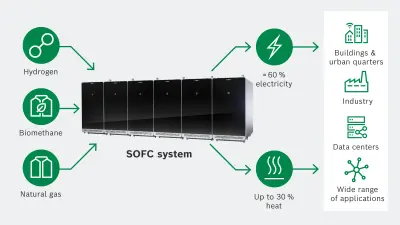How does our SOFC system work?
Our formula for efficient power generation

In goes fuel, out comes electricity and heat. It sounds so simple, but there’s much more to the electrochemical process in a fuel cell. The energy generated is efficient. And our solid oxide fuel cell (SOFC) can already run on fuels like natural gas and biomethane, which are converted to hydrogen in the fuel cell’s reformer. What’s important to know is that when it operates with natural gas or biomethane, carbon emissions are reduced by about two-thirds compared to power generation from coal. In the future, it will be possible to combine several SOFC systems, each with an output of 100 kW, to create a decentralized power supply solution in the megawatt range. Compared to coal-fired power plants, solid oxide fuel cells (SOFCs) emit over 4,000 metric tons less CO₂ per year for each megawatt of output. What’s even more important is the fact that our SOFC system will also be able to run on hydrogen in the future. The benefit of hydrogen as a fuel is that there are no CO2 emissions — other than electricity and heat, it only produces water!
Up to 90% overall efficiency
The output of the SOFC system is impressive. Just when generating power, its efficiency is approximately 60 percent at beginning of life. When the heat generated by the SOFC is also put to productive use, the SOFC system can even reach an overall efficiency of up to 90 percent.
What happens in the fuel cell?
To understand how natural gas, biomethane, and hydrogen are converted into electricity and heat, it is worthwhile looking inside the fuel cell. This is where reaction processes between the cathode and anode (electrodes) convert chemical energy into electrical energy.
The molecules of hydrogen, as the fuel gas, and oxygen are split into their elements in the solid oxide fuel cell and then react with each other. This produces direct current (DC) that is converted to alternating current (AC) in an inverter. Heat and water are also generated. The heat can be transferred as heat energy via an optional heat exchanger to a heating system, where it can be used to heat service water, for example.
The electrochemical reaction takes place at temperatures between 500 and 700 degrees Celsius. What makes this method of power generation special is that the production of nitrogen oxide and particulate matter is practically zero. When pure hydrogen is used as a fuel, not even CO2 is generated, giving a fuel cell system an edge over other power plants when it comes to sustainability.

What is the structure of the Bosch fuel cell system?
The smallest component part in a solid oxide fuel cell (SOFC) system is the cell itself. Several hundred cells are combined to form what is known as a fuel cell stack. Our partner for the development of fuel cell and stack technology is Ceres. What is unique about the Ceres SteelCell® is that the fuel cells are metal-supported and coated with ceramic.
The heart of the system is the SOFC stack, where chemical energy is converted into electrical energy. A hotbox will contain several stacks. This hotbox is combined with an air and gas supply system, an electronic control unit, and an exhaust system to form an SOFC unit. We supply SOFC technology to the market as a plug-&-play system. We combine several SOFC units with all the relevant auxiliary systems such as a heat exchanger, desulfurization unit, edge controller, and grid modules to create a standardized, ready-made system that delivers an output of 100 kW. Depending on requirements and the energy demand, it will be possible to use several of these systems together in the future to create a decentralized power supply system in the megawatt range.
Learn more about the areas of application for the Bosch fuel cell system.

The Bosch SOFC system is currently in the pilot phase. All technical specifications given are development objectives and refer to the beginning of life.



